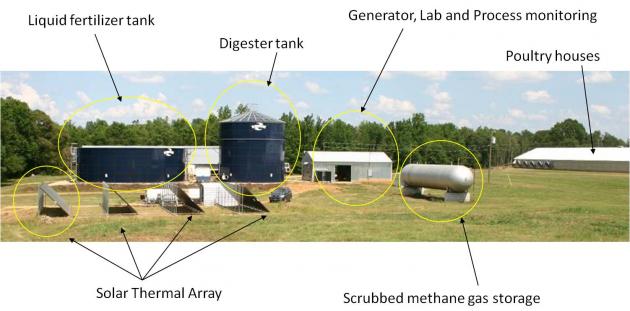![]() Waste to Worth home | More proceedings….
Waste to Worth home | More proceedings….
Abstract
Comprehensive on-farm resource utilization and renewable energy generation at the farm scale are not new concepts. However, truly encompassing implementation of these ideals is lacking. Brinson Farms operates 10 commercial broiler houses. The farm generates heat for its houses using biomass boilers and litter anaerobic digestion to produce methane. Solar panels assist in heating process water for the boilers and digester. Biomass feedstock includes litter as well as municipal yard wastes. Liquid fertilizer is a product of the digester while residual solids are included in the farm’s composting operation. The operator has used a futuristic approach to not only attain energy independence for the farm, but also to comprehensively utilize byproducts of production and other local “wastes”, diverting them from local landfills. Considering the propane cost for a single winter flock has reached $66,000 and the annual electric bill may be $120,000, energy costs very much affect grower profitability. This approach decreases the uncertainty in energy costs. Brinson Farms provides a unique look into ensuring long-term farm sustainability in an environmentally friendly way and with a wide-ranging systems approach to management.
Purpose
The purpose of the renewable energy project was to implement an innovative, sustainable solution to manage poultry manure and other organic waste products using anaerobic digestion as well as to demonstrate the ability to effectively and economically reduce dependence on outside utilities.
What Did We Do?
Brinson Farms demonstrates comprehensive utilization of local resources that have historically been viewed as wastes. These organic materials (broiler litter, yard trimmings, storm damaged trees and waste vegetables) come from both the farm and the community. Broiler litter and waste vegetables are anaerobically digested to produce methane. The methane is then used in three ways: 1) to generate electricity for the farm; 2) in boilers to heat water used in the digestion process; and 3) in dual-fuel biomass boilers to heat water for heat exchange in the broiler houses when biomass sources are low. Two other significant products from the digester include liquid fertilizer (approximately 5-2-3) that is sold and residual solids that are incorporated into the farm’s composting facility. Solar panels assist in heating water for the biomass boilers and the digester. The simple payback period for the on-farm poultry litter digester system is approximately 5 years.

Brinson Farms anaerobic digester complex. |
What Have We Learned?
Brinson Farms provides a unique system to ensure long-term farm sustainability in an environmentally beneficial manner. Attributes of the integrated system include: 1) bio-based energy production; 2) reduced utility costs; 3) comprehensive litter utilization; 4) no need to land apply poultry litter; 5) production of high quality, organic liquid fertilizer; 6) production of a marketable soil amendment (compost); and 7) diverting wastes from landfills. The farm/community interface is mutually advantageous. The farm uses yard trimmings and trees for energy and as a compost substrate; the community has a free repository to dispose of the biomass, where otherwise it would have to pay landfill fees.

Biomass storage and boiler to heat broiler houses |
Future Plans
Future plans include developing economic evaluations for each of the system components so that farmers can choose the renewable energy/value added process(es) that will best fit their local resources as well as short and long term financial plans.
Authors
Dana M. Miles, Chemical Engineer, USDA-ARS Genetics & Precision Agriculture Research Unit, Mississippi State, MS, dana.miles@ars.usda.gov
Additional Information
John Logan: johnlogan1@windstream.net;
Jeff Breeden: jbreeden@egesystems.com;
Eagle Green Energy: http://eaglegreenenergyinc.com/;
Arora, S. 2011. Poultry Manure: The New Frontier for Anaerobic Digestion. http://www.nrcs.usda.gov/Internet/FSE_DOCUMENTS/stelprdb1046769.pdf
Acknowledgements
The assistance of John Logan and Jeff Breeden to effectively describe the Brinson system is greatly appreciated.
The authors are solely responsible for the content of these proceedings. The technical information does not necessarily reflect the official position of the sponsoring agencies or institutions represented by planning committee members, and inclusion and distribution herein does not constitute an endorsement of views expressed by the same. Printed materials included herein are not refereed publications. Citations should appear as follows. EXAMPLE: Authors. 2013. Title of presentation. Waste to Worth: Spreading Science and Solutions. Denver, CO. April 1-5, 2013. URL of this page. Accessed on: today’s date.

